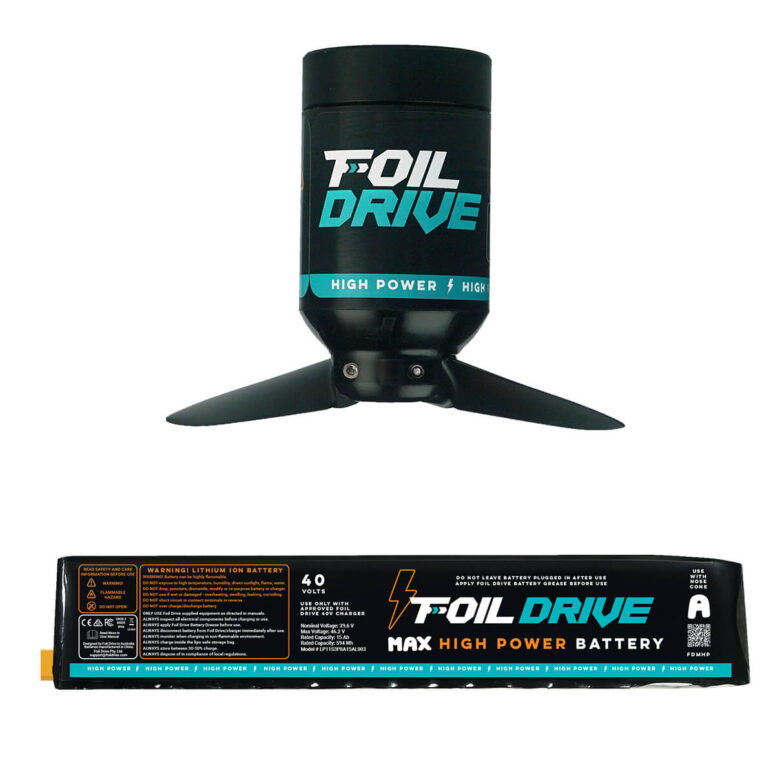

When you purchase gear through links on our site, we may earn a small commission. Here’s why you can trust our tests and our affiliate partner.

Picture the festive scene in a cold, snowy, almost Dickensian UK and two suspicious packages arrive from Australia. Foil Drive had sent some yuletide gifts that trumped the pair of socks from my Auntie, and perhaps even the Ryobi Multitool from my wife and child.
We’re around a year into the electrified juggernaut of success that’s been the Foil Drive Gen2, and various little upgrades, be it software or hardware, have been drip fed over the last six months, allowing some tweaking and a smidgen more boost. It was inevitable that more power would be an advantage, particularly to heavier riders, or those wishing to really downsize their foils for larger, faster wave conditions.
Compatibility with the existing Foil Drive Gen2 system and components is critical for these upgrades, and Foil Drive have no desire to irritate their existing user base. The new High Power Battery is in exactly the same form factor as the previous Max Power version, meaning it slides into the same nose cone A. In fact, apart from a blue stripe, you’d barely notice the difference visually, but it’s packing 100Wh more capacity at 594Wh versus 498.69Wh on the Max Power.
The High Power Motor is 10mm longer than the V2 motor, but the same diameter, meaning the stator has larger magnets, and a new rotor can is part of the package. This means your existing three (or two) blade prop can move across with no bother, and the existing modular cable system is also compatible. It weighs a fairly insignificant 160g more than the standard V2 motor. Again, you’d have to be quite pedantic to even notice.
We write with the important information that we’ve tested this mainly prone, with an inset 5’2 x 19” 30L board at 90kgs in realistic, harsh UK cold water conditions. Foils wise, we primarily used the Armstrong system utilizing HA1080, 880 and 680 front wings, with a quick dabble on the MA800. Waves have been anything from a foot to overhead and a half.
Our initial excitement meant we couldn’t help but plug both new components in together and feel the full force of the upgrades. Boost wise, we’re set to 124% on the app, but we’re assuming the teasing 128% will be unlocked with the official release of these new HP components if they are used in unison.
Immediately you feel the motor running more quietly and with a less aggressive tone and far less vibration through the board. It has significantly increased low-end torque, and the board builds surface speed and momentum with less fuss, and propellor cavitation. You get foiling faster and you may need to get your popup more snappy as a result. This is particularly noticeable in choppier conditions where the extra thrust ploughs the board through and up to speed.
Once motoring, the system doesn’t need to rev so hard, and you can use far less throttle to maintain a cruisy and efficient transport between the sets; this in turn extends battery life. It might be psychological, but we felt the new motor delivers acceleration in a more smooth and progressive manner.
The power increase means that you’ll immediately realize that you can drop a foil size, and still flat-water start, this is a massive bonus for those wanting to take their Foil Drive into more consequential surf and not feel overfoiled. In a bigger wave scenario, the extra torque allows you to match the wave speed and get off motor more easily, which equates to longer rides before the wave has pitched up properly. It also allows you to power yourself out of trouble more effectively.
Of course both High Power components are backwards compatible individually, there’s no necessity to use both together. Using the old V2 motor with the High Power Battery, you’ll get significantly more runtime, we think around 10-15 minutes in real world conditions.
Running the High Power Motor with the existing Max Power Battery yielded interesting results – with good technique, the extra torque got us on foil more quickly, so although you’re perhaps using a bigger spike of power to get up, you’re doing it for so much less time. We found if anything the new motor slightly increased or performed similar runtimes as the V2 motor.
If you had to choose one or the other, probably the most significant upgrade to the user experience is the HP Motor, rather than the HP Battery. That quiet and more effortless sensation and torque increase is brilliant regardless of the rider weight.
As a heavier multi-discipline rider, before the high-power upgrades, there was always a slight compromise for me with foil size, to make sure you could get yourself out of a sticky situation without a boost from a wave if necessary. I’d always run maybe a size up from where I would normally be comfortable to ensure a successful flat-water start without a chip in. These upgrades have brought my foil sizing in line with what I’d use winging and SUP foiling. This only aids your progression, as it’s easier to match the foil size to the wave. For me, these upgrades combined with an inset board have completely changed the scope of conditions I can tackle, and most critically, the feeling of Foil Drive, making it feel as exciting as any other discipline.